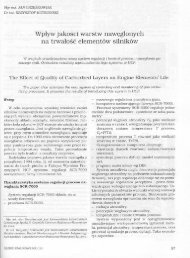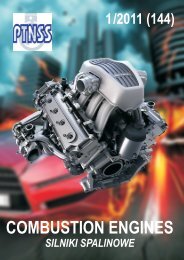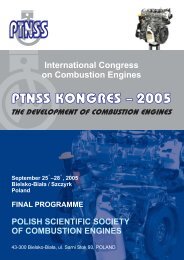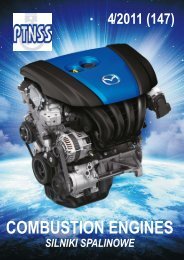Create successful ePaper yourself
Turn your PDF publications into a flip-book with our unique Google optimized e-Paper software.
Symulacja procesu spalania w dwupaliwowym silniku z dzieloną dawką oleju napędowego<br />
– A change in the dynamics of CNG combustion at a constant<br />
combustion angle obtained through changing of exponent<br />
m wg<br />
slightly influences the maximum values of the heat<br />
release rate from the gas (dQ/dα) g<br />
. It leads to a delay of the<br />
point of its occurrence, which has impact on the pressure<br />
changes in the high-pressure part of the combustion. The<br />
scale of these changes is smaller than in the case of CNG<br />
combustion angle. A change in the dynamics for range<br />
m wg<br />
= 1.0 ÷ 2.0 has almost no influence on the engine<br />
indicated efficiency and this is promising in terms of the<br />
possibilities of controlling of the gas mixture composition<br />
in actual engine processes.<br />
– The application of simulation research allows a varied<br />
evaluation of the combustion parameters and engine<br />
performance and facilitates reasoning when selecting the<br />
engine parameters. This should significantly reduce the<br />
costly engine tests.<br />
– The comparisons of the simulated pressure courses with the<br />
measured pressures indicate that the tested model should<br />
undergo an improvement, particularly in heat transfer to<br />
the walls. This will ensure a better convergence of the<br />
calculation results with the actual engine processes.<br />
– Zastosowanie badań symulacyjnych pozwala na różnorodne<br />
oceny parametrów spalania, osiągów silnika i ułatwia<br />
wnioskowanie przy doborze parametrów regulacyjnych<br />
silnika. Powinno to ograniczyć w znacznym stopniu<br />
kosztowne badania silnikowe.<br />
– Porównania symulowanych przebiegów ciśnień z ciśnieniami<br />
zmierzonymi wskazują, że badany model powinien<br />
być doskonalony, głównie w zakresie wymiany ciepła ze<br />
ściankami. Pozwoli to na lepsze dopasowanie wyników<br />
obliczeń do rzeczywistych procesów silnikowych.<br />
Paper reviewed/Artykuł recenzowany<br />
Bibliography/Literatura<br />
[1] Abd Alla G.H., Soliman H.A., Badr O.A., Abd Rabbo M.F.:<br />
Combustion quasi-two zone predictive model for dual fuel<br />
engines. Energy Conversion and Management 42 (2001)<br />
1477-1498, 2001.<br />
[2] Cailool Chr., Delorme T., Denis P., Berardi G., Porterie B.:<br />
A Combustion Model for Analyzing the Effects of Natural Gas<br />
Composition on the Operation of a Spark Ignition Engine. SAE<br />
Paper No. 2002-01-2236, 2002.<br />
[3] Hountalas D.T., Papagiannakis R.G.: A Simulation Model for<br />
the Combustion Process of Natural Gas Engines with Pilot Diesel<br />
Fuel as an Ignition Source. SAE Paper 2001-01-1245.<br />
[4] Singh S., Liang L., Kong S.C., Reitz R.D.: Development of a<br />
Flame Propagation Model for Dual-Fuel Partially Premixed<br />
Compression Ignition Engines. International Journal of Engine<br />
Research, vol. 7 no. 1, 65-75, 2006.<br />
[5] Matyjasik M.: Aktywizacja procesu spalania mieszaniny gazpowietrze<br />
w silnikach dwupaliwowych przez podział dawki<br />
inicjującej oleju napędowego. Rozprawa doktorska, ATH,<br />
Bielsko-Biała 2012.<br />
[6] Stelmasiak Z.: The Modeling of the Gas Combustion Course<br />
Using Theoretical Diphase Model that Describes the Combustion<br />
in a Dual Fuel Engine Fed with Both Natural Gas and<br />
Diesel Oil. Fisita 2002 World Automotive Congress, Paper<br />
No. F02 V211.<br />
[7] Stelmasiak Z.: Modelowanie przebiegu spalania w dwupaliwowym<br />
silniku o zapłonie samoczynnym zasilanym gazem.<br />
Polska Akademia Nauk Oddział w Krakowie, Teka Komisji<br />
Naukowo-Problemowej Motoryzacji nr ISDN 1642-1639, s.<br />
447-456, Kraków 2003. Konferencja n.t. Badania symulacyjne<br />
w technice samochodowej, Kazimierz Dolny 26-28 maja<br />
2003.<br />
[8] Stelmasiak Z., Larisch J., Gilowski T., Matyjasik M.: The<br />
optimization of combustion process in a dual fuel engine<br />
with Common Rail and gas injection systems, International<br />
Congress on Combustion Engines PTNSS KONGRES-2007<br />
„The Development of Combustion Engines”, Kraków 20-<br />
23.05.2007, Paper No. P07-C004.<br />
[9] Stelmasiak Z.: The Combustion Controlling in the Dual Fuel<br />
CI Engine by Pilot Dose Division, Combustion Engines No.<br />
3/2011.<br />
[10] Stelmasiak Z.: Possibility of Improvement of Some Parameters<br />
of Dual Fuel CI Engine by Pilot Dose Division, Journal of<br />
Polish Cimac, Vol. 6, No.1/2011, pp. 181-189, 2011.<br />
Zdzisław Stelmasiak, DSc., DEng. – Professor in<br />
the Faculty of Mechanical Engineering at University<br />
of Bielsko-Biala.<br />
Dr hab. inż. Zdzisław Stelmasiak, prof. ATH – profesor<br />
na. Wydziale Budowy Maszyn i Informatyki<br />
Akademii Techniczno-Humanistycznej w Bielsku-<br />
Białej.<br />
e-mail: zstelmasiak@ath.bielsko.pl<br />
Marcin Matyjasik, MEng. – doctoral student at<br />
the Faculty of Machine Design and Information<br />
Technology, University of Bielsko-Biała.<br />
Mgr inż. Marcin Matyjasik – doktorant na Wydziale<br />
Budowy Maszyn i Informatyki, Akademii Techniczno-Humanistycznej<br />
w Bielsku-Białej.<br />
54 <strong>COMBUSTION</strong> <strong>ENGINES</strong>, No. 4/2012 (151)












